Teaching, Learning and Assessment in Education and Training
32 Pages9916 Words35 Views
Added on 2023-01-19
About This Document
This document discusses the role and responsibilities of teachers and trainers in education and training, including key aspects of legislation, regulatory requirements, and code of practices. It also explores the relationships and boundaries between teaching and other professional roles. The importance of promoting appropriate behavior, equality, and diversity is highlighted, along with ways to establish and sustain a safe and inclusive learning environment. Opportunities for learners to provide feedback for inclusive practice are also discussed.
Teaching, Learning and Assessment in Education and Training
Added on 2023-01-19
ShareRelated Documents
Teaching, Learning and
Assessment in Education and
Training
Assessment in Education and
Training
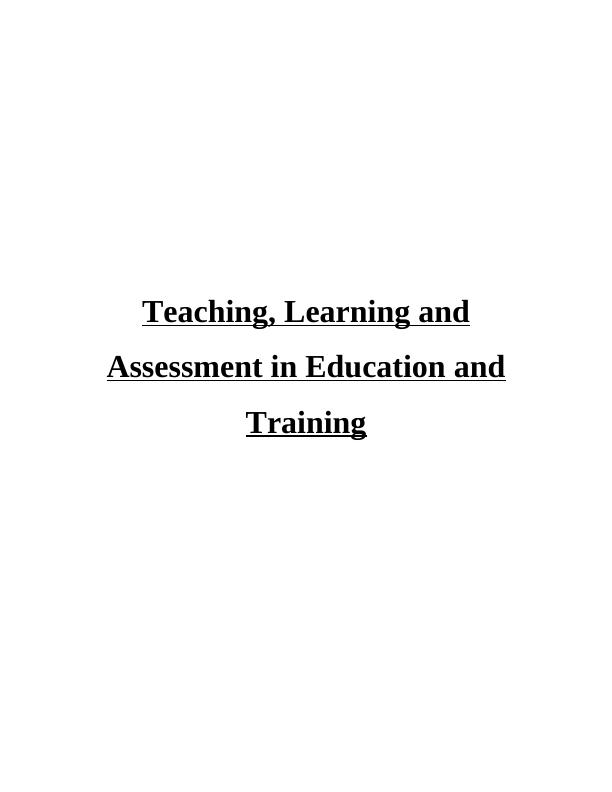

INTRODUCTION...........................................................................................................................1
TASK 1 Essay..................................................................................................................................1
1.1 Own role and responsibilities in education and training..................................................1
1.2 Key aspects of legislation, regulatory requirements and code of practices related to own
role and responsibilities..........................................................................................................2
1.3 Relationships and boundaries between the teaching role and other professional roles....2
TASK 2 Brochure............................................................................................................................3
4.1 Explain why it is important to promote appropriate behaviour and respect for others....3
4.2 Explain ways to promote equality and value diversity.....................................................4
4.3 Establish and sustain a safe, inclusive learning environment...........................................4
3.5 Opportunities for learners to provide feedback to inform inclusive practice...................5
TASK 3 Report................................................................................................................................5
1.4 Points of referral to meet the needs of learners................................................................5
2.1 Why it is important to identify and meet the individual needs of learners.......................6
2.2 Role and use of initial and diagnostic assessment in agreeing individual learning goals 6
2.3 Methods of initial and diagnostic assessment to agree individual learning goals with
learners...................................................................................................................................7
2.4 Record learners’ individual learning goals.......................................................................7
TASK 4 Create Scheme of Work.....................................................................................................8
3.1 Scheme of work in accordance with internal and external requirements.........................8
TASK 5 Lesson Plan (Annotated with key evidences)....................................................................8
3.2 Design teaching and learning plans that respond to:........................................................8
6.3 Use types and methods of assessment, including peer- and self assessment...................9
TASK 1 Essay..................................................................................................................................1
1.1 Own role and responsibilities in education and training..................................................1
1.2 Key aspects of legislation, regulatory requirements and code of practices related to own
role and responsibilities..........................................................................................................2
1.3 Relationships and boundaries between the teaching role and other professional roles....2
TASK 2 Brochure............................................................................................................................3
4.1 Explain why it is important to promote appropriate behaviour and respect for others....3
4.2 Explain ways to promote equality and value diversity.....................................................4
4.3 Establish and sustain a safe, inclusive learning environment...........................................4
3.5 Opportunities for learners to provide feedback to inform inclusive practice...................5
TASK 3 Report................................................................................................................................5
1.4 Points of referral to meet the needs of learners................................................................5
2.1 Why it is important to identify and meet the individual needs of learners.......................6
2.2 Role and use of initial and diagnostic assessment in agreeing individual learning goals 6
2.3 Methods of initial and diagnostic assessment to agree individual learning goals with
learners...................................................................................................................................7
2.4 Record learners’ individual learning goals.......................................................................7
TASK 4 Create Scheme of Work.....................................................................................................8
3.1 Scheme of work in accordance with internal and external requirements.........................8
TASK 5 Lesson Plan (Annotated with key evidences)....................................................................8
3.2 Design teaching and learning plans that respond to:........................................................8
6.3 Use types and methods of assessment, including peer- and self assessment...................9
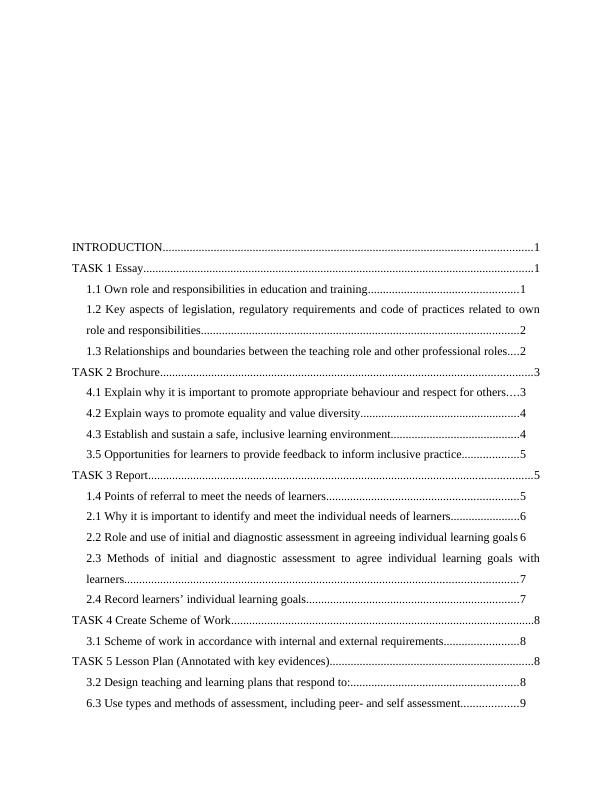
6.4 Use questioning and feedback to contribute to the assessment process...........................9
6.5 Record the outcomes of assessments to meet internal and external requirements.........10
6.6 Communicate assessment information to other professionals with an interest in learner
achievement..........................................................................................................................10
7.1 Analyze ways in which minimum core elements can be demonstrated in planning,
delivering and assessing inclusive teaching and learning....................................................11
7.2 Apply minimum core elements in planning, delivering and assessing inclusive teaching
and learning..........................................................................................................................11
TASK 6 Reflective Account..........................................................................................................12
3.3 How own planning meets the individual needs of learners............................................12
3.4 Ways in which teaching and learning plans can be adapted to meet the individual needs of
learners.................................................................................................................................12
TASK 7..........................................................................................................................................13
6.1 Explain the purposes and types of assessment used in education and training..............13
6.2 Analyze the effectiveness of assessment methods in relation to meeting the individual
needs of learners...................................................................................................................14
TASK 8..........................................................................................................................................14
5.2 Analyse benefits and limitations of communication methods and media used in own area
of specialism.........................................................................................................................14
5.3 Analyse the effectiveness of resources used in own area of specialism in relation to
meeting the individual needs of learners..............................................................................15
5.4 Use inclusive teaching and learning approaches and resources, including technologies, to
meet the individual needs of learners...................................................................................16
5.5 Demonstrate ways to promote equality and value diversity in own teaching................16
5.6 Adapt teaching and learning approaches and resources, including technologies to meet the
individual needs of learners..................................................................................................17
5.7 Communicate with learners and learning professionals to meet individual learning needs
..............................................................................................................................................18
TASK 9..........................................................................................................................................18
5.1 Analyse the effectiveness of teaching and learning approaches used in own area of
specialism in relation to meeting the individual needs of learners.......................................18
6.5 Record the outcomes of assessments to meet internal and external requirements.........10
6.6 Communicate assessment information to other professionals with an interest in learner
achievement..........................................................................................................................10
7.1 Analyze ways in which minimum core elements can be demonstrated in planning,
delivering and assessing inclusive teaching and learning....................................................11
7.2 Apply minimum core elements in planning, delivering and assessing inclusive teaching
and learning..........................................................................................................................11
TASK 6 Reflective Account..........................................................................................................12
3.3 How own planning meets the individual needs of learners............................................12
3.4 Ways in which teaching and learning plans can be adapted to meet the individual needs of
learners.................................................................................................................................12
TASK 7..........................................................................................................................................13
6.1 Explain the purposes and types of assessment used in education and training..............13
6.2 Analyze the effectiveness of assessment methods in relation to meeting the individual
needs of learners...................................................................................................................14
TASK 8..........................................................................................................................................14
5.2 Analyse benefits and limitations of communication methods and media used in own area
of specialism.........................................................................................................................14
5.3 Analyse the effectiveness of resources used in own area of specialism in relation to
meeting the individual needs of learners..............................................................................15
5.4 Use inclusive teaching and learning approaches and resources, including technologies, to
meet the individual needs of learners...................................................................................16
5.5 Demonstrate ways to promote equality and value diversity in own teaching................16
5.6 Adapt teaching and learning approaches and resources, including technologies to meet the
individual needs of learners..................................................................................................17
5.7 Communicate with learners and learning professionals to meet individual learning needs
..............................................................................................................................................18
TASK 9..........................................................................................................................................18
5.1 Analyse the effectiveness of teaching and learning approaches used in own area of
specialism in relation to meeting the individual needs of learners.......................................18

8.1 Assess the effectiveness of practice in planning, delivering and assessing...................19
8.2 Identify areas for improvement in practice in planning, delivering and assessing........20
CONCLUSION..............................................................................................................................20
REFERENCES..............................................................................................................................21
8.2 Identify areas for improvement in practice in planning, delivering and assessing........20
CONCLUSION..............................................................................................................................20
REFERENCES..............................................................................................................................21
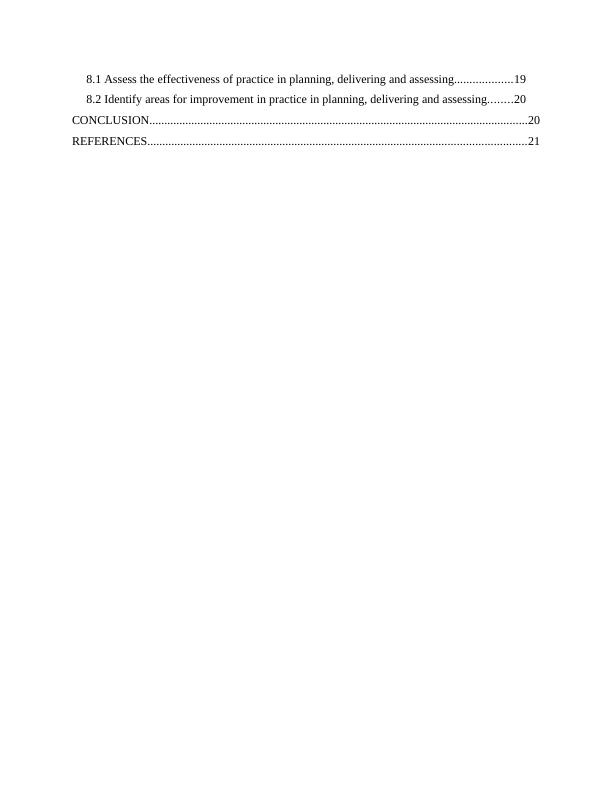
INTRODUCTION
Education is all related to the learning of theory as well as traditionally education may
reinforce knowledge in which individual already have a foundation. On the other hand, training
is totally different from education because it gives skill to individual for doing something instead
of just knowing about something (De Gloria, Bellotti and Berta, 2014). Along with this, training
is specific towards particular need, vocation as well as skills-gap. Moreover, through education
mainly theoretical knowledge will be gained but by training practical skills develop. This report
is based education and training it will going to discuss role of individual within it. Along with,
aspects of legislation, regulatory requirement as well as code of practices related to the own
responsibilities.
Most important thing which will going to discuss is relationship and boundaries within
teaching and other professional role. Apart from this, several other factors which included within
education and training session going to be highlighted within this report such as importance of
promoting appropriate behaviour, ways to promote equality and diversity. In addition to this,
benefits as well as limitations of communication methods and media used in education &
training will be highlighted. Furthermore, several other teaching and learning approaches will be
be explained which use for meeting needs of individuals. Along with this benefits as well as
limitations of communication methods will be discuss.
TASK 1 Essay
1.1 Own role and responsibilities in education and training
In present time, both training and teaching could be considered as some of crucial
elements that helps students in gaining knowledge in regards to a particular subject. Basically,
teacher along with trainer's role is to train on a particular subject, which may aid students in a
way which actively involve and engage the learners in every session. On the other side, it is also
said that both teaching and training are not enough but, learning is one of the crucial factor which
mainly pulls out specific results in specified time frame. It is being analysed that, some key
aspects of role and responsibilities as a teacher could be considered as, carrying out initial and/or
diagnostic assessments, clear communication with the specified learners, other professionals and
stakeholders, promoting appropriate behaviour and respect for others, identifying and meeting
learners’ needs, being aware of the support mechanisms available, organise educational
1
Education is all related to the learning of theory as well as traditionally education may
reinforce knowledge in which individual already have a foundation. On the other hand, training
is totally different from education because it gives skill to individual for doing something instead
of just knowing about something (De Gloria, Bellotti and Berta, 2014). Along with this, training
is specific towards particular need, vocation as well as skills-gap. Moreover, through education
mainly theoretical knowledge will be gained but by training practical skills develop. This report
is based education and training it will going to discuss role of individual within it. Along with,
aspects of legislation, regulatory requirement as well as code of practices related to the own
responsibilities.
Most important thing which will going to discuss is relationship and boundaries within
teaching and other professional role. Apart from this, several other factors which included within
education and training session going to be highlighted within this report such as importance of
promoting appropriate behaviour, ways to promote equality and diversity. In addition to this,
benefits as well as limitations of communication methods and media used in education &
training will be highlighted. Furthermore, several other teaching and learning approaches will be
be explained which use for meeting needs of individuals. Along with this benefits as well as
limitations of communication methods will be discuss.
TASK 1 Essay
1.1 Own role and responsibilities in education and training
In present time, both training and teaching could be considered as some of crucial
elements that helps students in gaining knowledge in regards to a particular subject. Basically,
teacher along with trainer's role is to train on a particular subject, which may aid students in a
way which actively involve and engage the learners in every session. On the other side, it is also
said that both teaching and training are not enough but, learning is one of the crucial factor which
mainly pulls out specific results in specified time frame. It is being analysed that, some key
aspects of role and responsibilities as a teacher could be considered as, carrying out initial and/or
diagnostic assessments, clear communication with the specified learners, other professionals and
stakeholders, promoting appropriate behaviour and respect for others, identifying and meeting
learners’ needs, being aware of the support mechanisms available, organise educational
1

programs and to become reflective, and this could be considered as learning from successes as
well as mistakes too. On the other side, there are number of roles as well as responsibilities that a
trainer carries and these are training plan, timing of different training sessions, choosing the
relevant training methods, preparing the training materials and aids, conducting training sessions
and evaluating the post training session and many more.
1.2 Key aspects of legislation, regulatory requirements and code of practices related to own role
and responsibilities
There are several important legislations, regulations as well as code of practices which
have to be included within education and training. Explanation of these are as follows :-
Equality Act (2010), Main motive behind introducing this act is to protects people against
discrimination, harassment or victimisation. Along with this, Equality Act state that there should
be no discrimination within human beings on the basis of following factors such as age, gender,
disability, race, religion, sex, beliefs and so many. Thus, it is important for teacher or trainer to
implement this act within education and training so that equal opportunity will be provided to
everyone. Data protection Act 2018, This Act state that Data of individual have to be protected
and not disclose with other without permission. Along with this, as digital world is getting
develop so it is important for teacher and trainer to fit data protection law with digital age as well
as empower people to take care of there data. Because disclose of information result in creating
discrimination and several other unlawful activities. Thus, implementation of these legislation
within education and training session result in conducting overall practices within effective
manner and help in providing training and education in proper manner without any unlawful
practices.
1.3 Relationships and boundaries between the teaching role and other professional roles
Teaching is the procedure through which people's needs, feeling, experience as well as
intervening can be attended so they will learn particular things. In simple term, teacher is the
human being who assist people in learning something as well as they work in classroom. On the
other hand, professional is the term which related to anyone who earns their living by performing
an activity that need some specific level of education, skills as well as training. There is wide
relation within teacher and professional role because they both are working for developing skills
and knowledge of particular person. As teacher help student in developing creativity same as
2
well as mistakes too. On the other side, there are number of roles as well as responsibilities that a
trainer carries and these are training plan, timing of different training sessions, choosing the
relevant training methods, preparing the training materials and aids, conducting training sessions
and evaluating the post training session and many more.
1.2 Key aspects of legislation, regulatory requirements and code of practices related to own role
and responsibilities
There are several important legislations, regulations as well as code of practices which
have to be included within education and training. Explanation of these are as follows :-
Equality Act (2010), Main motive behind introducing this act is to protects people against
discrimination, harassment or victimisation. Along with this, Equality Act state that there should
be no discrimination within human beings on the basis of following factors such as age, gender,
disability, race, religion, sex, beliefs and so many. Thus, it is important for teacher or trainer to
implement this act within education and training so that equal opportunity will be provided to
everyone. Data protection Act 2018, This Act state that Data of individual have to be protected
and not disclose with other without permission. Along with this, as digital world is getting
develop so it is important for teacher and trainer to fit data protection law with digital age as well
as empower people to take care of there data. Because disclose of information result in creating
discrimination and several other unlawful activities. Thus, implementation of these legislation
within education and training session result in conducting overall practices within effective
manner and help in providing training and education in proper manner without any unlawful
practices.
1.3 Relationships and boundaries between the teaching role and other professional roles
Teaching is the procedure through which people's needs, feeling, experience as well as
intervening can be attended so they will learn particular things. In simple term, teacher is the
human being who assist people in learning something as well as they work in classroom. On the
other hand, professional is the term which related to anyone who earns their living by performing
an activity that need some specific level of education, skills as well as training. There is wide
relation within teacher and professional role because they both are working for developing skills
and knowledge of particular person. As teacher help student in developing creativity same as
2
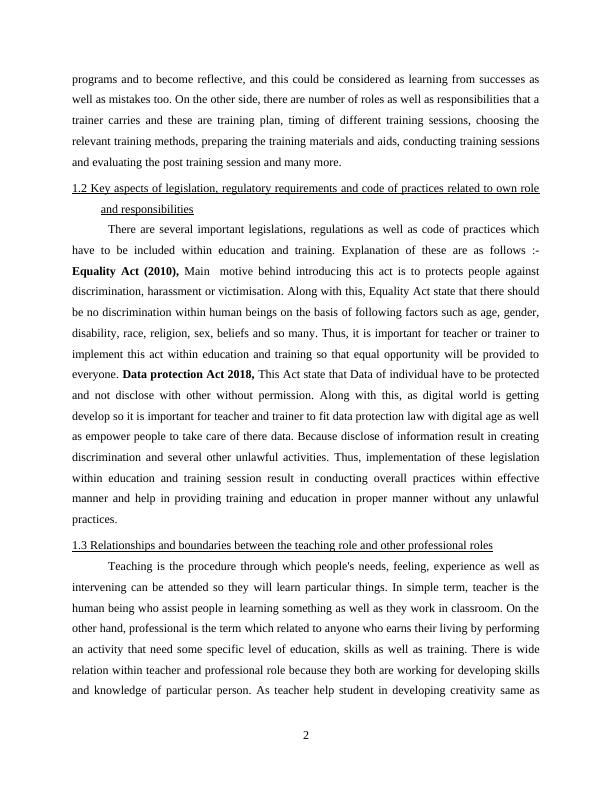
professional help employees and other people in developing there skills as well as knowledge
related to particular thing. Thus, there is wide relation within role of teacher and professionals.
Along with this relation there is some boundaries also within both of them, teacher within
their profession are needed to maintain proper standards as well as fulfil their responsibilities
which is not just to learners but also for colleagues, institution and other area where they are
working as teacher. For conducting such activities within effective manner it is important for
teacher to set there personal as well as professional boundaries. This will set limits as well as
help in identifying what involve in professional roles. In addition to this, setting boundaries is
best way that use for defining professional duties, limitations and right of professional worker as
an teacher. When it comes to setting boundaries as teacher it is essential define duties and
everything that included in professional.
TASK 2 Brochure
Scenario
A school has added cap as a school uniform for all male pupils at school in order to
maintain uniformity at workplace. But, this implementation of this rule was not done effectively
as the school is consist of diverse culture pupil that includes Sikh boys too. According to the
Sikh culture male pupil studying in this skill was not wear cap as they are carry turban every
day. This develops indirect kind of discrimination at school because, school staff can not force
Sikh boys to quit their cultural value.
4.1 Explain why it is important to promote appropriate behaviour and respect for others
It is essential for all individuals who works in a teaching field to focus on treating each
and every pupil in learning area premises with respect. They are also required to follow some
basic behaviour mode so that surrounding would remain calm. With reference to given scenario,
it can be said that its mandatory for the school to give respect to the culture of every religion so
that better environment can be developed and parents of children can also feel satisfy that their
children are studying in right zone. It has been scene that the school has allowed Sikh boys to
follow their culture and moulded their norms accordingly. This has shown that appropriate
importance has been given to culture which depicts respect towards one another. Further, it has
been seen that this leniency of abidance of regulation in terms of culture has created
discrimination at school but, still it is essential for all sectors whether it belongs to academic
3
related to particular thing. Thus, there is wide relation within role of teacher and professionals.
Along with this relation there is some boundaries also within both of them, teacher within
their profession are needed to maintain proper standards as well as fulfil their responsibilities
which is not just to learners but also for colleagues, institution and other area where they are
working as teacher. For conducting such activities within effective manner it is important for
teacher to set there personal as well as professional boundaries. This will set limits as well as
help in identifying what involve in professional roles. In addition to this, setting boundaries is
best way that use for defining professional duties, limitations and right of professional worker as
an teacher. When it comes to setting boundaries as teacher it is essential define duties and
everything that included in professional.
TASK 2 Brochure
Scenario
A school has added cap as a school uniform for all male pupils at school in order to
maintain uniformity at workplace. But, this implementation of this rule was not done effectively
as the school is consist of diverse culture pupil that includes Sikh boys too. According to the
Sikh culture male pupil studying in this skill was not wear cap as they are carry turban every
day. This develops indirect kind of discrimination at school because, school staff can not force
Sikh boys to quit their cultural value.
4.1 Explain why it is important to promote appropriate behaviour and respect for others
It is essential for all individuals who works in a teaching field to focus on treating each
and every pupil in learning area premises with respect. They are also required to follow some
basic behaviour mode so that surrounding would remain calm. With reference to given scenario,
it can be said that its mandatory for the school to give respect to the culture of every religion so
that better environment can be developed and parents of children can also feel satisfy that their
children are studying in right zone. It has been scene that the school has allowed Sikh boys to
follow their culture and moulded their norms accordingly. This has shown that appropriate
importance has been given to culture which depicts respect towards one another. Further, it has
been seen that this leniency of abidance of regulation in terms of culture has created
discrimination at school but, still it is essential for all sectors whether it belongs to academic
3
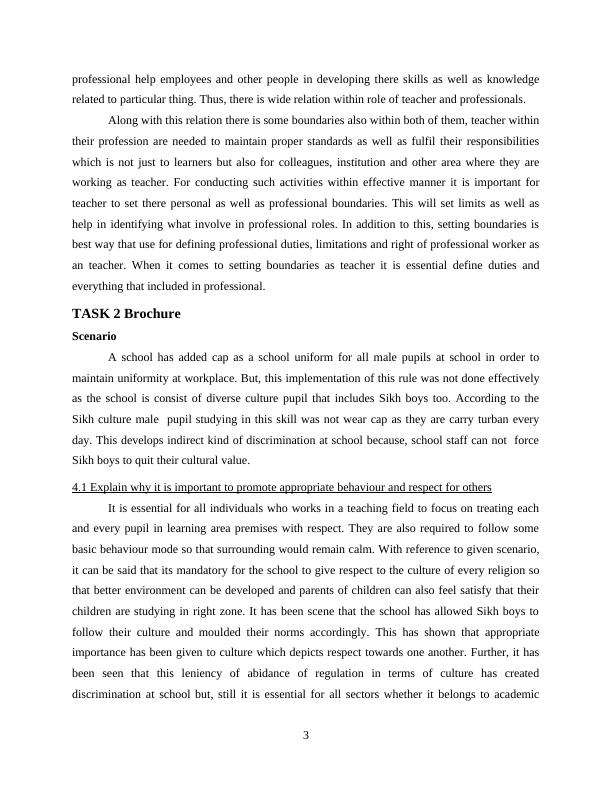
End of preview
Want to access all the pages? Upload your documents or become a member.
Related Documents
Teaching Learning and Assessment in Education and Training UNIT 426lg...
|18
|5902
|420
Planning, Delivering and Assessing Learners in Own Specialist Arealg...
|23
|7096
|51
Teaching Learning and Assessment in Education and Traininglg...
|17
|4875
|394
Planning to Meet the Needs of Learners in Education and Traininglg...
|31
|7484
|125
Teaching Learning and Assessment in Education and Training UNIT 426lg...
|21
|5926
|326
Teaching Learning and Assessment in Education and Traininglg...
|18
|5542
|288
